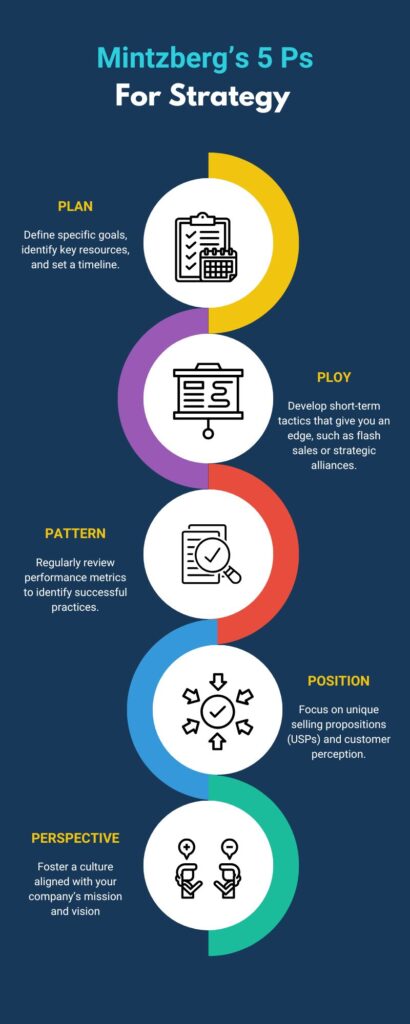In today’s complex business landscape, strategy isn’t just a one-dimensional plan—it’s a multifaceted approach that encompasses diverse perspectives. Henry Mintzberg, a renowned management theorist, introduced the “5 Ps for Strategy” framework to help organizations build a comprehensive strategy that’s adaptable, sustainable, and aligned with their goals. But what exactly are these 5 Ps, and how can you leverage them in your business? Let’s dive into Mintzberg’s model and explore how to make each “P” work for your organization.
What are Mintzberg’s 5 Ps of Strategy?
Mintzberg’s 5 Ps—Plan, Ploy, Pattern, Position, and Perspective—represent distinct ways of viewing strategy. Each “P” offers a unique angle to consider, helping leaders build a nuanced and effective strategy that can adapt to changing circumstances.
Let’s examine each component in detail.

1. Plan
In Mintzberg’s framework, a strategy as a Plan represents a deliberate, intentional course of action aimed at achieving specific goals. This is the most traditional way of thinking about strategy: as a roadmap that guides a business from point A to point B.
Application: To implement strategy as a Plan, companies need to define clear objectives, allocate resources, and create timelines to reach their goals. Plans should be flexible enough to adapt to unexpected challenges but detailed enough to guide daily operations.
- Example: A software company might develop a strategic plan to launch a new app, outlining each step from development to market launch. They’ll consider timelines, budgeting, and team allocation to ensure the project meets their objectives.
Key Takeaway: Strategy as a Plan provides structure and a sense of direction. However, it requires adaptability to remain relevant in an ever-evolving business environment.
2. Ploy
Strategy as a Ploy focuses on competitive tactics. It involves short-term actions designed to outmaneuver competitors, sometimes with bold moves that create a temporary advantage.
Application: Ploys can range from strategic pricing decisions to unique marketing campaigns or even exclusive partnerships that disrupt competitors. These tactics are often time-sensitive and intended to deliver immediate results that position the business advantageously in the market.
- Example: A retail company might lower prices just before a competitor’s product launch to capture market attention and drive sales.
Key Takeaway: While a Ploy can offer short-term benefits, businesses should avoid relying too heavily on it. Strategic ploys work best as part of a larger plan, enhancing competitiveness without compromising long-term goals.
3. Pattern
Strategy as a Pattern refers to consistency in decision-making and actions over time. Rather than being a one-time plan or reactionary tactic, it reflects an organization’s repeated behaviors that indicate its strategic direction.
Application: By analyzing past behaviors and successes, leaders can identify patterns that contribute to growth. This is particularly useful for businesses aiming to create reliable processes that support long-term sustainability.
- Example: A company that consistently invests in customer service training may build a reputation for quality service. Over time, this becomes a pattern and a core component of the business’s strategy.
Key Takeaway: Pattern is about consistency and long-term focus. By identifying and reinforcing positive patterns, companies can strengthen their identity and ensure that their actions align with strategic goals.
4. Position
Strategy as a Position is about determining where a business stands in the market relative to competitors. This component involves defining a unique market position that differentiates the company and appeals to target customers.
Application: Positioning is critical in competitive industries where standing out is necessary for success. Businesses can use branding, customer experience, and unique selling propositions (USPs) to solidify their market position.
- Example: A premium electronics brand may position itself as a luxury option, appealing to customers who value high quality and innovative design over cost. This clear positioning helps it stand out among budget brands.
Key Takeaway: A well-defined Position allows a business to differentiate itself in a crowded market. Clear positioning helps companies attract the right audience and build brand loyalty.
5. Perspective
Strategy as a Perspective goes beyond external positioning to focus on the internal culture and mindset of an organization. This component emphasizes the values, beliefs, and worldview that shape how a business approaches challenges and opportunities.
Application: Leaders can cultivate a strong perspective by aligning team values with the company’s mission and vision. This helps create a consistent culture, which in turn influences decision-making and the company’s approach to innovation and resilience.
- Example: A sustainability-focused company might incorporate eco-friendly practices into all operations, from product sourcing to packaging. This perspective influences every business decision and becomes a defining feature of the company’s identity.
Key Takeaway: Perspective adds depth to strategy by infusing it with purpose and values. A strong perspective can inspire employees, build customer loyalty, and foster resilience in times of change.
Why Are Mintzberg’s 5 Ps Important for Today’s Businesses?
Mintzberg’s 5 Ps remain relevant because they acknowledge the complex, multi-dimensional nature of strategy. Businesses today face rapid technological changes, market volatility, and evolving customer expectations. By leveraging the 5 Ps, leaders can develop a flexible, resilient approach that addresses both internal and external factors.
Understanding and applying all 5 Ps ensures that strategy is not just a plan on paper but a comprehensive approach that guides daily actions, adapts to market conditions, and strengthens organizational identity.
Read more: A Guide to Profitable Business Growth with Pricing Strategy
How to Implement Mintzberg’s 5 Ps in Your Business
Here are actionable steps for applying each of the 5 Ps:
- Plan: Set specific goals, identify key resources, and develop a timeline that can adjust as needed.
- Ploy: Identify a few competitive tactics, like promotional offers or limited-time collaborations, that can help gain market attention quickly.
- Pattern: Review performance regularly to identify successful practices and areas for improvement, then create repeatable processes.
- Position: Define your unique selling points (USPs) and invest in branding efforts that reinforce your place in the market.
- Perspective: Establish a clear company mission and vision. Ensure that all team members understand and contribute to this perspective.
Conclusion
Mintzberg’s 5 Ps offer a well-rounded view of strategy that goes beyond traditional planning. By considering strategy as a Plan, Ploy, Pattern, Position, and Perspective, leaders can build a resilient approach that adapts to change, reinforces the company’s values, and achieves sustainable growth.
Which of Mintzberg’s 5 Ps resonates most with your current business strategy? Leave a comment and let us know!


